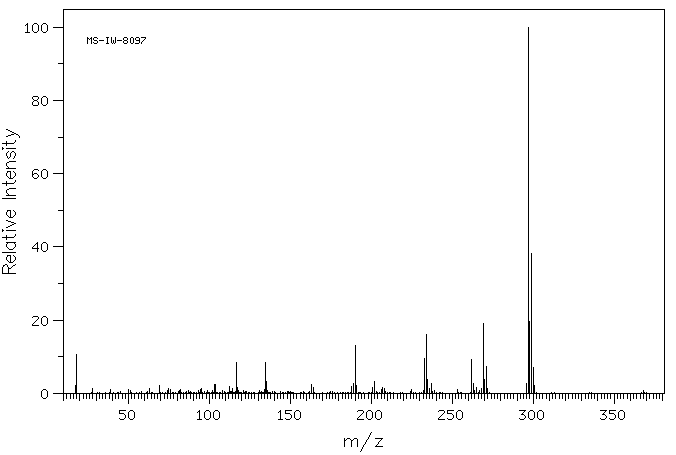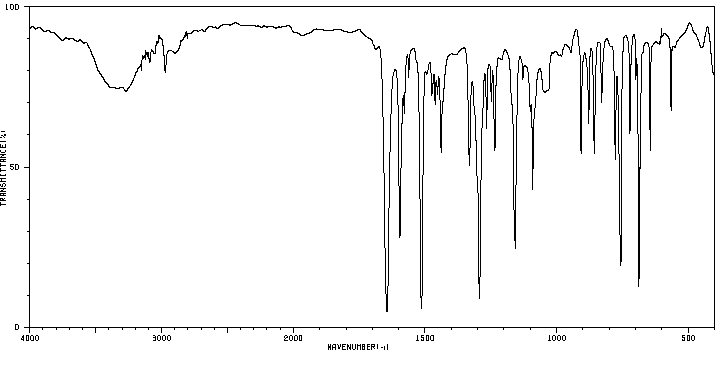6-chloro-5H-benzo[a]phenothiazin-5-one | 25947-05-1
中文名称
——
中文别名
——
英文名称
6-chloro-5H-benzo[a]phenothiazin-5-one
CAS
25947-05-1
化学式
C16H8ClNOS
mdl
——
分子量
297.765
InChiKey
ZUZCXZWQSZASNG-UHFFFAOYSA-N
BEILSTEIN
——
EINECS
——
-
物化性质
-
计算性质
-
ADMET
-
安全信息
-
SDS
-
制备方法与用途
-
上下游信息
-
文献信息
-
表征谱图
-
同类化合物
-
相关功能分类
-
相关结构分类
计算性质
-
辛醇/水分配系数(LogP):4.3
-
重原子数:20
-
可旋转键数:0
-
环数:4.0
-
sp3杂化的碳原子比例:0.0
-
拓扑面积:54.7
-
氢给体数:0
-
氢受体数:3
上下游信息
-
下游产品
中文名称 英文名称 CAS号 化学式 分子量 苯并[a]吩噻嗪-5-酮 5H-Benzophenothiazin-5-one 25947-04-0 C16H9NOS 263.32 —— 6-phenyl-5H-benzophenothiazin-5-one 86673-54-3 C22H13NOS 339.417
反应信息
-
作为反应物:描述:6-chloro-5H-benzo[a]phenothiazin-5-one 在 palladium diacetate 、 2-三丁基甲锡烷基噻吩 、 cesium fluoride 、 2-二环己基磷-2,4,6-三异丙基联苯 作用下, 以 1,4-二氧六环 为溶剂, 生成 苯并[a]吩噻嗪-5-酮参考文献:名称:快速获取新的角吩噻嗪和苯恶嗪染料摘要:描述了一些新的硫代苯基衍生的和呋喃基衍生的吩噻嗪和吩恶嗪染料的合成。在合成6-氯-5 H-苯并[a]吩噻嗪-5-,6-氯-5 H-苯并[a]吩恶嗪-5-和6-氯5之后,通过两种方法实现了这一目的。H萘[2,1-b]吡啶基[2,3-e] [1,4]恶嗪-5-酮中间体通过2,3-二氯-1,4-萘醌与2-氨基硫酚的无水碱缩合反应, 2-氨基苯酚和2-氨基吡啶醇。第一种方法涉及在温和的碱性化学式(CsF)和1,4-二恶烷或甲苯溶剂中于80°C下用氯吩噻嗪/氯吩恶嗪处理三丁基(噻吩-2-基)或三丁基(呋喃-2-基)锡烷。以高产量供应令人眼花yellow乱的黄色固体。在第二种方法中,催化体系在乙腈中预活化,然后加入偶联剂和K 3 PO 4以中等到高产量获得高熔点和各种颜色鲜艳的产品。反应条件与未保护的NH和羰基官能团相容。这些染料的强烈颜色以及Na 2 S 2 O 4还原的衍生物易于再氧化,使其适合用DOI:10.1002/jhet.2569
-
作为产物:描述:2,3-二氯-1,4-萘醌 、 2-氨基苯硫醇 在 sodium carbonate 作用下, 以 N,N-二甲基甲酰胺 、 苯 为溶剂, 反应 8.0h, 以85%的产率得到6-chloro-5H-benzo[a]phenothiazin-5-one参考文献:名称:Synthesis of Benzothiazinophenothiazine Derivatives and their Antimicrobial Screening摘要:合成苯硫噻嗪苯噻嗪衍生物的研究从简单的杂环化合物入手,进行了深入探讨。中间体6-氯-5H-苯并[a]噻嗪-5-酮是通过将2-氨基硫酚与2,3-二氯-1,4-萘醌在碱性介质中缩合得到的。进一步将该中间体与通过碱水解2,4-二氨基-6-羟基-5-硫氰基嘧啶得到的2,4-二氨基-6-羟基-5-硫噻唑缩合,得到7-氨基-9-羟基-6-8-二氮苯并[a][1,4]苯硫噻嗪[3,2-c]苯噻嗪。然而,采用酸催化法成功实现了其他四种苯硫噻嗪环系的合成,且产率较高,反应时间较短。利用紫外-可见光谱、傅里叶变换红外光谱、氢核磁共振谱(1H NMR)、碳核磁共振谱(13C NMR)和元素分析进行了结构确认。合成的化合物对一些微生物进行了筛选,结果显示这些复合衍生物对微生物具有显著的活性。DOI:10.13005/ojc/300406
文献信息
-
Micelles catalyzed one pot regio- and chemoselective synthesis of benzo[a]phenazines and naphtho[2,3-d]imidazoles ‘in H2O’作者:Vishnu K. Tandon、Manoj K. Verma、Hardesh K. Maurya、Sandeep KumarDOI:10.1016/j.tetlet.2014.09.103日期:2014.11An efficient, novel, and concise one pot regio- and chemoselective synthesis of benzo[a]phenazines (4) and naphtho[2,3-d]imidazoles (8) has been accomplished in excellent yields by nucleophilic substitution reaction of 2,3-dichloro-1,4-naphthoquinone (1) with o-phenylenediamine (2) and benzamidines (7) respectively ‘in H2O’ using base and micelles (SDS) as catalyst. Analog reaction of 2,3-dichloro-1
-
Synthesis and structure of new alkynyl derivatives of phenothiazine and phenoxazine作者:Efeturi A. Onoabedje、Uchechukwu C. Okoro、Amitabha Sarkar、David W. KnightDOI:10.1080/17415993.2015.1131827日期:2016.5.3ABSTRACT New alkynyl derivatives of phenothiazine and phenoxazine were obtained via Sonogashira cross-coupling reactions. This was achieved by first synthesizing the intermediates 6-chloro-5H-benzo[a]phenothiazin-5-one, 6-chloro-5H-benzo[a]phenoxazin-5-one and 6-chloro-5H-naphtho[2,1-b]pyrido[2,3-e][1,4]oxazin-5-one by anhydrous base-catalyzed condensations between 2,3-dichloro-1,4-naphthoquinone and摘要 通过 Sonogashira 交叉偶联反应获得了吩噻嗪和吩恶嗪的新型炔基衍生物。这是通过首先合成中间体 6-氯-5H-苯并[a]吩噻嗪-5-one、6-氯-5H-苯并[a]吩恶嗪-5-one和6-氯-5H-萘并[2, 1-b]pyrido[2,3-e][1,4]oxazin-5-one 通过 2,3-二氯-1,4-萘醌和 2-氨基苯硫酚、2-氨基苯酚和 2 之间的无水碱催化缩合-氨基吡啶,这些富含电子的氯吩噻嗪和氯吩恶嗪中间体与末端炔烃的交叉偶联,在 80°C 的乙腈中使用 4 mol% Pd 和 7 mol% XPhos,提供高度着色的炔基化衍生物收益良好。这些反应条件允许引入未保护的 NH 和羰基。
-
Fuctionalization of Linear and Angular Phenothiazine and Phenoxazine Ring Systems via Pd(0)/XPhos Mediated Suzuki-Miyaura Cross-coupling Reactions作者:Efeturi A. Onoabedje、Uchechukwu C. Okoro、David W. Knight、Amitabha SarkarDOI:10.1002/jhet.2485日期:2016.11Chloro‐substituted phenothiazines and phenoxazines were successfully derivatized with phenylboronic and styrylboronic acids using Suzuki–Miyaura cross‐coupling reaction catalyzed by Pd(0)/XPhos for the first time in good yields. The protocol employed 4 mol% Pd and 7 mol% XPhos with K3PO4 in acetonitrile at 80°C. The reaction condition is compatible with carbonyl and unprotected N–H groups in substrates
-
Utility of Suzuki-Miyaura Cross-Coupling Reaction in Synthesis of Benzo[a]phenothiazine and Benzo[a]phenoxazine Derivatives and their Antimicrobial Screening作者:Jude I. Ayogu、Benjamin E. Ezema、Chidimma G. EzemaDOI:10.14233/ajchem.2015.19182日期:——Palladium-catalyzed Suzuki-Miyaura cross-coupling reactions of 6-chloro-5H-benzo[a]phenothiazin-5-one (1), 11-amino-6-chloro-9-thio-5H-naphtho[2,1-b]pyrimido[5,4-e][1,4]oxazin-5-one (2) and 6-chloro-5H-naphtho[2,1-b]pyrido[2,3-e][1,4]oxazin-5-one (3) with phenylboronic acid and 3-nitrophenylboronic acid were thoroughly investigated. The above intermediates were prepared by the reactions of 2-aminothiophenol, 4,5-diamino-6-hydroxylpyrimidine-2-thiol and 2-aminopyridin-3-ol each with 2,3-dichloronaphthalene-1,4-dione in a basic medium using benzene/DMF as the solvent. Thereafter, each was subjected to the Suzuki-Miyaura coupling reaction with phenylboronic acid and 3-nitrophenyl boronic acid, refluxing for 7-8 h at 110 °C using tris(dibenzylideneacetone)palladium(0), dicyclohexyl-phosphino-2,6-dimethoxybiphenyl (SPhos), potassium phosphate and toluene as the catalyst, ligand, base and solvent correspondingly to yield the derivatives (1a-b), (2a-b) and (3a-b), respectively. Structures of the compounds were characterized using UV/visible spectrophotometry, FT-IR, 1H NMR and 13C NMR spectroscopy and elemental analysis. The compounds were screened against six micro-organisms, viz: Bacillus subtitis, Staphylococcus aureus, Pseudomonas aeruginosa, Escherichia coli, Candida albicans and Aspergillus niger and were shown to have significant activity against some Gram-positive micro-organisms.在催化的铃木-宫浦交叉偶联反应中,研究了6-氯-5H-苯并[a]噻嗪-5-酮(1)、11-氨基-6-氯-9-硫-5H-萘[2,1-b]嘧啶[5,4-e][1,4]氧杂啉-5-酮(2)以及6-氯-5H-萘[2,1-b]嘧啶[2,3-e][1,4]氧杂啉-5-酮(3)与苯硼酸和3-硝基苯硼酸的交联反应。这些中间体通过将2-氨基硫酚、4,5-二氨基-6-羟基嘧啶-2-硫醇和2-氨基吡啶-3-醇分别与2,3-二氯萘-1,4-二酮在基础介质中使用苯/DMF作为溶剂反应准备而成。随后,将每种化合物与苯硼酸和3-硝基苯硼酸进行铃木-宫浦耦合反应,在110 °C下回流7-8小时,使用三(双苯乙烯)丙烯镍(0)、二环己基磷烷-2,6-二甲氧基联苯(SPhos)、磷酸钾和甲苯作为催化剂、配体、碱和溶剂,最终得到了衍生物(1a-b)、(2a-b)和(3a-b)。使用紫外/可见光分光光度法、FT-IR、1H NMR和13C NMR光谱法以及元素分析对化合物的结构进行表征。这些化合物在六种微生物(如:杜氏芽孢杆菌、金黄色葡萄球菌、绿脓杆菌、大肠杆菌、白色念珠菌和黑曲霉)中进行了筛选,显示出对一些革兰阳性微生物具有显著的活性。
-
Electrochemical Synthesis of Phenothiazinone as Fluorophore and Its Application in Bioimaging作者:Qian Wang、Yue‐Xi Chen、Su‐Hui Ji、Jian‐Min Zhou、Ren‐Hao Li、Yun‐Rui CaiDOI:10.1002/chem.202302124日期:2023.11.21Electrochemical synthesis of phenothiazinone via oxidative cyclocondensation of quinone and 2-aminothiophenol under mild condition is presented, along with its bio-application as fluorophore for lipid droplets imaging in living cells.
表征谱图
-
氢谱1HNMR
-
质谱MS
-
碳谱13CNMR
-
红外IR
-
拉曼Raman
-
峰位数据
-
峰位匹配
-
表征信息
同类化合物
(S)-溴烯醇内酯
(R)-3,3''-双([[1,1''-联苯]-4-基)-[1,1''-联萘]-2,2''-二醇
(3S,3aR)-2-(3-氯-4-氰基苯基)-3-环戊基-3,3a,4,5-四氢-2H-苯并[g]吲唑-7-羧酸
(3R,3’’R,4S,4’’S,11bS,11’’bS)-(+)-4,4’’-二叔丁基-4,4’’,5,5’’-四氢-3,3’’-联-3H-二萘酚[2,1-c:1’’,2’’-e]膦(S)-BINAPINE
(11bS)-2,6-双(3,5-二甲基苯基)-4-羟基-4-氧化物-萘并[2,1-d:1'',2''-f][1,3,2]二氧磷
(11bS)-2,6-双(3,5-二氯苯基)-4羟基-4-氧-二萘并[2,1-d:1'',2''-f][1,3,2]二氧磷杂七环
(11bR)-2,6-双[3,5-双(1,1-二甲基乙基)苯基]-4-羟基-4-氧化物-二萘并[2,1-d:1'',2''-f][1,3,2]二氧杂磷平
黄胺酸
马兜铃对酮
马休黄钠盐一水合物
马休黄
食品黄6号
食品红40铝盐色淀
飞龙掌血香豆醌
颜料黄101
颜料红70
颜料红63
颜料红53:3
颜料红5
颜料红48单钠盐
颜料红48:2
颜料红4
颜料红261
颜料红258
颜料红220
颜料红22
颜料红214
颜料红2
颜料红19
颜料红185
颜料红184
颜料红170
颜料红148
颜料红147
颜料红146
颜料红119
颜料红114
颜料红 9
颜料红 21
颜料橙7
颜料橙46
颜料橙38
颜料橙3
颜料橙22
颜料橙2
颜料橙17
颜料橙 5
颜料棕1
顺式-阿托伐醌-d5
雄甾烷-3,17-二酮








